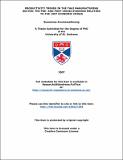Files in this item
Productivity trends in the Thai manufacturing sector: the pre- and post-crisis evidence relating to the 1997 economic crisis
Item metadata
| dc.contributor.advisor | Reid, Gavin C. | |
| dc.contributor.author | Arunsawadiwong, Suwannee | |
| dc.coverage.spatial | 339 | en |
| dc.date.accessioned | 2007-09-14T15:17:31Z | |
| dc.date.available | 2007-09-14T15:17:31Z | |
| dc.date.issued | 2007-07-13 | |
| dc.identifier | uk.bl.ethos.552033 | |
| dc.identifier.uri | https://hdl.handle.net/10023/369 | |
| dc.description.abstract | The principal aim of this thesis is to examine the validity of the claim that low productivity led to a decline in Thailand’s competitiveness, and hence, to the 1997 economic crisis. For a decade from 1985 to 1995, Thailand was one of the world’s fastest-growing economies with an average real annual GDP growth of 8.4 percent. However, such growth was criticized as being simply the result of large inward investment and rapid accumulation of capital, leading to very little productivity growth, and therefore, being unsustainable in the long run. Worse still, the later surges of capital inflows came in mainly as speculative stashes, instead of as foreign direct investments in production and businesses. Hence, as predicted, the boom finally came to a sudden end in 1997. The economic growth statistics recorded severe contraction, financial market collapsed, the currency was battered, domestic demand slumped, severe excess capacity was experienced, employment deteriorated, personal and corporate income diminished, inflation and the cost of living mounted, and finally, poverty surged. This thesis utilizes a stochastic production frontier approach to verify the claim that low productivity lessened Thailand’s competitiveness. This approach, unlike the standard econometric approach, allows the existence of technical inefficiency in the production process. It also, unlike other non-parametric approaches, recognizes that such inefficiency can sometimes occur as a result of external factors that are out of the firms’ direct control, such as statistical errors and random shocks. The period covered in this thesis is from 1990 to 2002. This is divided into 2 sub-periods, i.e. the pre-crisis period (1990 – 1996) and the post-crisis period (1997 – 2002). The estimation results indicate a structural shift in the Thai manufacturing sector, from being labour intensive in the pre-crisis period to being capital intensive in the post-crisis period. The productivity level also improved post-crisis, as compared to the pre-crisis level, and is shown to follow an increasing trend. The low productive investment level in the pre-crisis period is identified as having led to the decline in the manufacturing sector’s efficiency. The thesis concludes that this low productivity level did indeed lead to the decline in Thailand’s competitiveness, and hence, to the decline of export growth, which was at that time the main source of Thailand’s economic growth; in turn, playing an important role in precipitating the 1997 economic crisis. | en |
| dc.format.extent | 5044449 bytes | |
| dc.format.mimetype | application/pdf | |
| dc.language.iso | en | en |
| dc.publisher | University of St Andrews | |
| dc.rights | Creative Commons Attribution-NonCommercial-NoDerivs 3.0 Unported | |
| dc.rights.uri | http://creativecommons.org/licenses/by-nc-nd/3.0/ | |
| dc.subject | Stochastic frontier production | en |
| dc.subject | Efficiency estimates | en |
| dc.subject | Thailand | en |
| dc.subject | 1997 economic crisis | en |
| dc.subject | Productivity | en |
| dc.subject | Productivity measurement | en |
| dc.subject.lcc | HB3722.A8 | |
| dc.subject.lcsh | Manufacturing industries--Thailand--Labor productivity--Econometric models | en |
| dc.subject.lcsh | Competition--Thailand--Economic models | en |
| dc.subject.lcsh | Financial crises--Thailand | en |
| dc.title | Productivity trends in the Thai manufacturing sector: the pre- and post-crisis evidence relating to the 1997 economic crisis | en |
| dc.type | Thesis | en |
| dc.contributor.sponsor | Ministry of Foreign Affairs of the Kingdom of Thailand | en |
| dc.type.qualificationlevel | Doctoral | en |
| dc.type.qualificationname | PhD Doctor of Philosophy | en |
| dc.publisher.institution | The University of St Andrews | en |
This item appears in the following Collection(s)
Except where otherwise noted within the work, this item's licence for re-use is described as Creative Commons Attribution-NonCommercial-NoDerivs 3.0 Unported
Items in the St Andrews Research Repository are protected by copyright, with all rights reserved, unless otherwise indicated.


